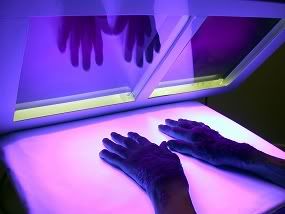
PUVA is a form of repigmentation therapy where a type of medication called psoralen is given before exposure to ultraviolet light A (thus the name PUVA). It is generally used for people with more extensive Vitiligo (affecting greater than 20% of the body), and is the mainstay of treatment for Vitiligo patients. Psoralen makes the skin very sensitive to light. Combined with UVA, it stimulates the production of the pigment melanin in the skin. Basically, it serves to help the patient tan faster in a small amount of time. PUVA therapy has a 50-70% chance of returning color on the face, trunk, and upper arms and legs, whereas hands and feet respond poorly.Psoralen can be taken by mouth or applied to the skin as a paint and can even be added to bathwater, in which case the hands and/or feet are soaked in the mixture for 30 minutes and then immediately exposed to UVA. In most cases, at least a year of twice weekly treatments are required in order to see good results. PUVA hand therapy
Types of PUVA: A man receiving PUVA therapy
Instructions (from DermNet NZ):
- Topical PUVA - A thin coat of psoralen is applied to depigmented patches of Vitiligo 30 minutes before UVA light exposure. This type of PUVA therapy is often used for people with a small number of depigmented patches (affecting less than 20% of the body) and can also be used for children as young as 2 years old.
- Oral PUVA - A prescribed dose of psoralen is taken in pill-form by mouth 2 hours before UVA light or sunlight exposure. This type of PUVA therapy is often used for people with more extensive Vitiligo (affecting greater than 20% of the body) and is not recommended for children under the age of 10 because of the increased risk of damage to the eyes, such as cataracts.
- Keep all scheduled appointments. Allow time for changing.
- Tell the staff about your health problems, including medications and eye disease.
- Do not apply any ointments or cosmetics except as directed by your doctor or phototherapist.
- Schedule treatments at the same time of day whenever possible.
- Alcohol consumption should be minimal.
- Avoid [additional] sun exposure on treatment and non-treatment days.
- Apply broad spectrum sunblock to face and hands before treatment.
- Cover male genitalia--this area must not be exposed to UVA.
- Wear the special goggles provided during treatment.
- Wear wrap-around ultraviolet-protective sunglasses both indoors and outdoors after treatment.
- After dark, sunglasses must still be worn under fluorescent lighting.
- Wear fully-covering clothing outdoors and if near a window indoors.
- Apply sunscreen to all uncovered skin after treatment.
- Arrange to be seen regularly by your dermatologist.
- burning (sunburn) and redness
- headache
- nausea and vomiting
- itching
- eye damage (if goggles are not worn during UVA treatment, or if special UVA-blocking glasses are not worn 24 hours after therapy)
- premature skin damage and/or aging
- nonmelanoma skin cancer
- cataracts
- discolored spots on skin
If you have any stories, rants, or theories of your own about Vitiligo--or just need some encouragement and support--visit the forum now! :)
Check out the forum here!
 PUVA hand therapy
PUVA hand therapy A man receiving PUVA therapy
A man receiving PUVA therapy